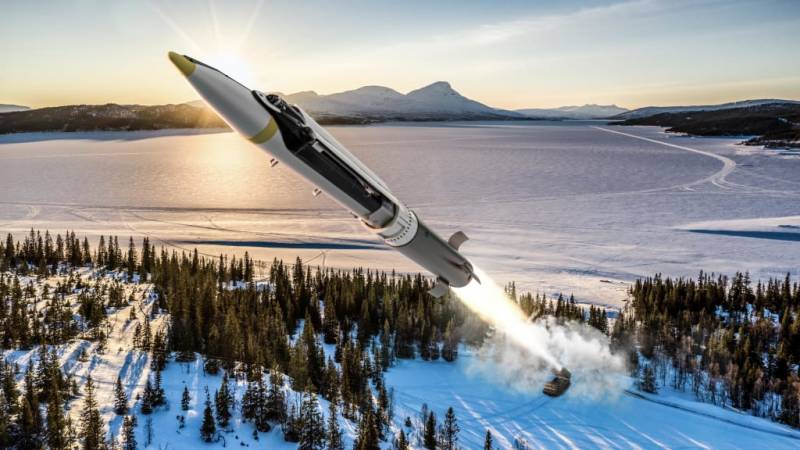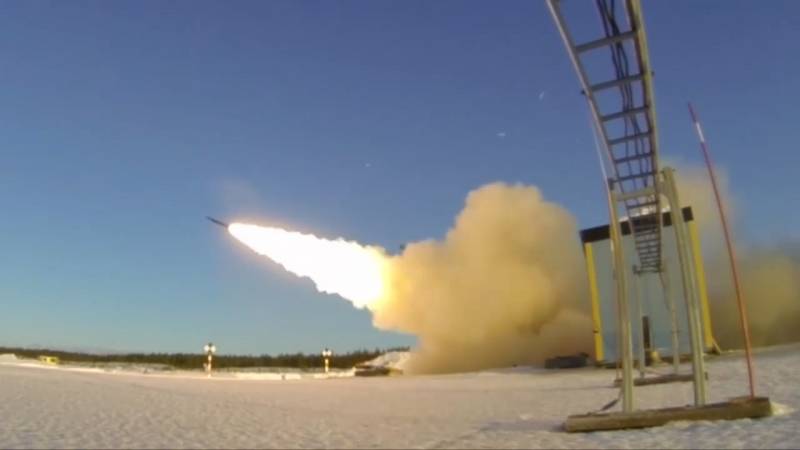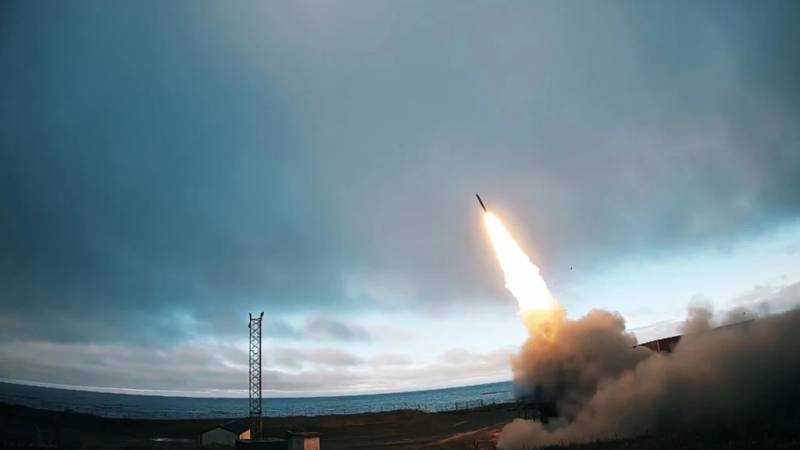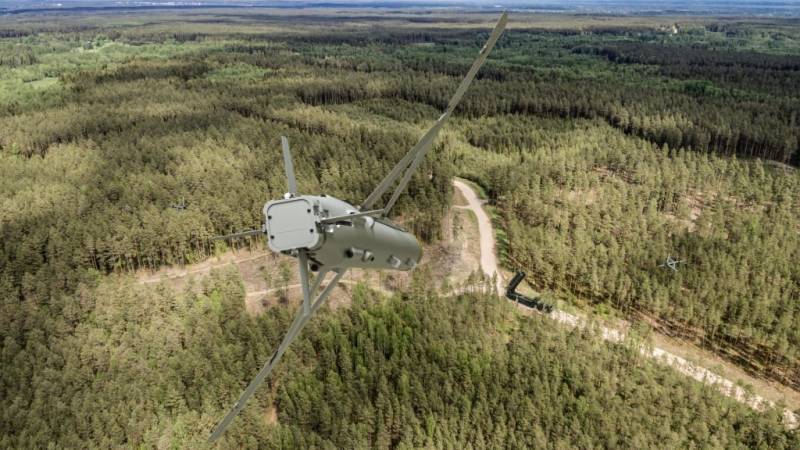GLSDB missiles for Ukraine: issue resolved?

GLSDB rocket in launch configuration
Over the past few months, the foreign press has reported several times that the United States is going to transfer promising GLSDB guided missiles to the Kyiv regime. However, so far such news received no confirmation and the delivery has not started yet. Just the other day this weapon mentioned again in the context of military assistance - and in the very near future it will become known whether these reports correspond to reality.
According to unconfirmed reports
For the first time, the American news agency Reuters reported about the possible shipment of GLSDB precision-guided munitions to Ukraine at the end of November. According to him, the Boeing company, which developed it and prepared the production line, took the initiative to supply such weapons. It was noted that this is not the first proposal to launch the production of weapons specifically for deliveries to Ukraine.
According to Reuters, the US Department of Defense has received the proposal and is considering it. At the time of the news, a decision on the supply of GLSDB had not yet been made. At the same time, three unnamed sources told the agency that the first batch of such weapons could be transferred to Kyiv only in the spring of 2023.
Over the next few weeks, there were no reports of possible deliveries of GLSDB. However, in mid-January, it became known that the next package of American military-technical assistance was being prepared, and such missiles were remembered again. So, on January 18, the American publication Politico published some information about the package received from its sources.

"Combat stage" in the form of a bomb after engine separation
It was reported about the upcoming delivery of various types of armored vehicles, including Stryker vehicles, as well as a variety of ammunition. In particular, they called the shipment of GLSDB products likely. At the same time, the volumes and timing of the provision of these weapons were not named. In addition, the transfer of other long-range missile systems was excluded.
The very next day, January 19, the Pentagon officially announced the expected aid package. It included two dozen positions with a total value of approx. 2,5 billion. As expected, deliveries of armored vehicles, anti-aircraft systems and ammunition are planned. GLSDB missiles are not mentioned in the document - at least openly. At the same time, it cannot be ruled out that they were “hidden” in the line about additional rockets for HIMARS multiple rocket launchers.
In the next package
New details soon emerged. On February 1, Reuters, citing its sources, revealed the Pentagon's new plans. It follows from his message that GLSDB products were not included in the latest assistance package. At the same time, the decision on deliveries has been made, and such ammunition will be included in the next batch of aid. Officially, the new package will be announced during this week - until February 5 inclusive. The total value of the allocated products this time will exceed $2 billion.
Reuters sources indicate that the GLSDB missiles for this package will be made specifically for Ukraine. In the near future, the US presidential administration and the Department of Defense will place an order for the production of such weapons as part of the Ukraine Security Assistance Initiative.

First start of GLSDB on trials, 2015
According to the latest news from Reuters, the US is ready to provide the Kyiv regime with GLSDB ammunition, but their supply is associated with certain difficulties. So, there are no finished products yet - the White House and the Pentagon have only made the necessary decisions and are only preparing to place an order for their production. The volume and cost of the future contract have not yet been disclosed. Also, the timing of its implementation and sending the first batches of weapons to the recipient is questionable.
In late November, it was reported that Boeing would be able to send the first GLSDBs to Ukraine during the spring. It is possible that such estimates were given taking into account the immediate receipt of the order and the start of production. Just over two months have passed since then, and the hypothetical start date for deliveries should have shifted to the right accordingly. It should be noted that certain difficulties are possible at the stage of launching production, which will also negatively affect the timing of the order.
rocket and bomb
The Ground-Launched Small Diameter Bomb guided munition is one of the latest US developments in the field of high-precision weapons. It has been developed by Boeing and Saab (Sweden) since the early 2015s. In XNUMX, the project was brought to field tests, and over the next few years, Boeing and Saab performed fine-tuning of the design and demonstrated the main functions of the product.
To date, the GLSDB ammunition has passed all the tests and is preparing for full-fledged mass production. The Pentagon is already planning to purchase such weapons for its needs. Now it has become known about the possible placement of an order - to assist Ukraine.

The GLSDB project is based on the curious idea of combining two ready-made components to obtain fundamentally new combat capabilities. Such ammunition is actually a GBU-39 Small Diameter Bomb with an attached solid propellant engine from an M26 rocket for the MLRS / HIMARS MLRS.
The use of only available components greatly simplifies and reduces the cost of production and operation. Thus, the cost of a serial product assembled from components from warehouses is set at $40. An operational-tactical missile of the ATACMS family with close range characteristics costs more than a million. However, an aerial bomb carries a much smaller warhead.
The bomb-based missile is fully compatible with existing US-style MLRS and is launched from a standard container. New variants of self-propelled launchers on different bases and with different features are also offered.
After starting with the help of a solid propellant rocket engine, the product enters a given trajectory, gains the required height and speed, after which the engine is reset. Further, a combat stage in the form of an aerial bomb GBU-39 flies to the target. Despite the unusual way of launching, the bomb retains all the basic functions and capabilities.
The characteristics and combat qualities of the GLSDB are mainly determined by the parameters of the GBU-39 bomb. This ammunition is 1,8 m long with an outer diameter of less than 200 mm. Weight - 129 kg, incl. warhead weighing up to 93 kg, depending on modification. The bomb has a streamlined body, and is also equipped with a folding wing and plumage, with the help of which it carries out a gliding flight along the required trajectory.

Various modifications of the GBU-39 bomb are equipped with an inertial / satellite guidance system, a semi-active laser or active radar homing head. The combat capabilities of the bomb depend on the type of guidance means. Thus, guidance based on navigation systems allows you to attack only stationary targets, while laser and radar seekers ensure the defeat of moving ones. At the same time, a modification with a laser head needs to illuminate the target.
During tests, the GLSDB product showed a flight range of more than 130 km - when launched into the front hemisphere of the launcher. It is also possible to attack a target behind the starting position. Part of the engine energy is spent on the maneuver, and the flight range is reduced to 70 km.
The question of opposition
The United States is only deciding whether to provide the Kyiv regime with GLSDB ammunition. If a positive decision is made and Boeing receives an order, deliveries of finished products will begin only in a few months. Missiles of a new type will appear in the combat zone no earlier than spring-summer. Of course, if Washington decides to supply them.
However, the Russian army is already ready for the adversary to have such weapons and will be able to effectively deal with them. The fact is that the GLSDB product, despite starting from the ground, is actually a conventional gliding guided bomb. This is a small-sized sub- or supersonic maneuvering aerodynamic target - in fact, a typical target for air defense systems.

Disguised launcher variant from GLSDB promotional material
Modern Russian anti-aircraft missile systems designed for military and facility air defense are capable of detecting, attacking and hitting a variety of air targets, including precision weapons such as guided bombs. Similar capabilities of the Tor, Pantsir complexes, etc. repeatedly worked out in exercises, and now they are being confirmed in the framework of real hostilities.
During the current Special Operation, our air defense has repeatedly demonstrated the defeat of various air targets, incl. difficult to intercept. Thus, a large number of MLRS / HIMARS guided missiles were successfully destroyed in the air. In addition, AGM-88 anti-radar missiles are regularly intercepted. All this means that the GBU-39 bombs as part of the GLSDB system are not fundamentally difficult and can be detected and destroyed.
For promotional purposes
According to US media reports, the Pentagon and the White House have been debating for several months whether to transfer the new GLSDB precision-guided missiles to the Kyiv regime. According to the latest news, a positive decision has been made and will be announced in the coming days. Nevertheless, it cannot be ruled out that such weapons will again not be included in the new aid package, and their delivery will again be postponed indefinitely.
In the context of the delivery of GLSDB, the American leadership will have to solve a specific problem. It is directly interested in supporting Kyiv and maintaining the combat capability of its formations. To do this, they allow the transfer of various weapons and equipment, incl. modern and promising. At the same time, the GLSDB missile is one of the latest American developments, and this product is planned to be promoted on the international arms market.
The fighting in Ukraine is seen as an opportunity to test modern weapons in real conditions, as well as show them to potential buyers. However, Russian air defense is capable of spoiling such an advertising campaign and depriving the United States of orders for a new product. Whether Washington will choose to support an ally or profit from its industry will become clear in the near future.
Information